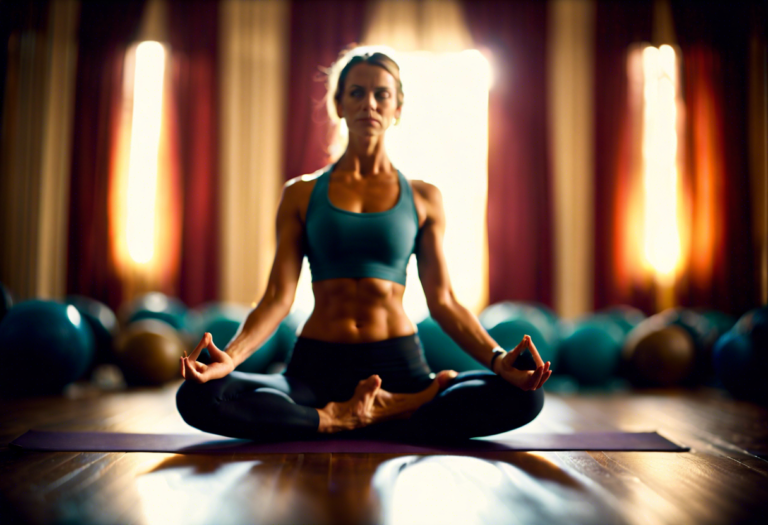Guidelines For Athletes Who Incorporate Yoga Into Their Training Regime
Benefits of Yoga for Athletes
Yoga has gained significant popularity among athletes as a complementary training tool to improve performance, enhance flexibility, and aid in injury prevention. The ancient practice of yoga offers numerous benefits that can positively impact athletes of all levels and disciplines. yoga into an athlete’s training regime can lead to improvements in physical and mental well-being, ultimately enhancing overall athletic performance.
Improving Flexibility and Range of Motion
One of the key benefits of yoga for athletes is the enhancement of flexibility and range of motion. Many yoga poses focus on stretching and lengthening muscles, tendons, and ligaments, which can help athletes improve their overall flexibility. Increased flexibility can lead to improved performance in various sports by allowing athletes to move more freely and efficiently.
Enhancing Strength and Balance
Yoga is not only about flexibility but also about building strength and improving balance. Many yoga poses require athletes to support their body weight in different positions, helping to develop strength in various muscle groups. Additionally, practicing balancing poses can improve proprioception and stability, which are essential for preventing injuries in athletes.
Injury Prevention and Rehabilitation
Yoga can play a vital role in injury prevention and rehabilitation for athletes. By strengthening muscles, increasing flexibility, and improving body awareness, yoga can help athletes reduce the risk of injuries. For those recovering from injuries, yoga offers a gentle way to regain strength and mobility while promoting healing and recovery.
Stress Reduction and Mental Clarity
Engaging in yoga practices can also benefit athletes mentally by reducing stress and promoting mental clarity. The focus on breath awareness and mindfulness in yoga can help athletes manage stress, anxiety, and pressure, which are common in competitive sports. By incorporating yoga into their routine, athletes can enhance their mental resilience and concentration, leading to improved performance under pressure.
Enhancing Respiratory Efficiency
Yoga emphasizes the connection between breath and movement, promoting proper breathing techniques that can enhance respiratory efficiency. Athletes can benefit from improved breathing patterns, which can increase oxygen intake, improve endurance, and optimize performance during training and competition.
Promoting Recovery and Relaxation
After intense training sessions or competitions, athletes often need to prioritize recovery and relaxation to allow their bodies to rest and repair. Yoga offers gentle stretches, restorative poses, and relaxation techniques that can help athletes unwind, reduce muscle tension, and promote overall recovery, leaving them feeling refreshed and rejuvenated for future training sessions.
Yoga into Training Regime
To reap the full benefits of yoga, athletes should consider incorporating it into their training regime regularly. Whether through dedicated yoga sessions, cross-training classes, or online tutorials, finding a balance between yoga and their primary sport can help athletes achieve optimal results. Consulting with a certified yoga instructor or sports performance specialist can ensure that the yoga practice aligns with the athlete’s specific needs and goals.
The benefits of yoga for athletes are numerous and diverse, encompassing physical improvements, mental well-being, injury prevention, and overall performance enhancement. By integrating yoga into their training regime, athletes can experience holistic growth, both on and off the field. Embracing the principles of yoga can empower athletes to cultivate a balanced body-mind connection, ultimately unlocking their full athletic potential.
Key Yoga Poses for Enhancing Athletic Performance
Yoga has gained significant popularity among athletes due to its numerous physical and mental benefits that can enhance athletic performance. yoga into a regular training regime can help athletes improve flexibility, strength, balance, and focus. By practicing key yoga poses tailored to address specific needs, athletes can experience a positive impact on their overall performance.
Benefits of Yoga for Athletes
Yoga offers a holistic approach to fitness that complements traditional athletic training. Athletes who incorporate yoga into their routine often experience reduced risk of injuries, improved recovery time, and enhanced mental clarity. The mindful breathing techniques used in yoga can also aid in stress reduction and promote relaxation, contributing to better performance on and off the field.
Downward-Facing Dog (Adho Mukha Svanasana)
This classic yoga pose is excellent for stretching the calves, hamstrings, and shoulders. Athletes, especially runners and cyclists, can benefit from the lengthening of the posterior chain, which helps improve overall flexibility and range of motion in the legs and upper body.
Warrior II (Virabhadrasana II)
Warrior II pose is ideal for strengthening the legs, core, and arms. It helps athletes develop stability, focus, and endurance, which are essential for various sports activities. This pose also opens up the hips and chest, improving overall posture and alignment.
Tree Pose (Vrksasana)
Tree pose is great for enhancing balance and concentration. Athletes can improve their stability and proprioception by practicing this pose regularly. It also strengthens the ankles and legs, providing a solid foundation for dynamic movements in sports that require quick changes in direction.
Pigeon Pose (Eka Pada Rajakapotasana)
Pigeon pose is beneficial for athletes looking to release tension in the hips and glutes. It can help improve hip mobility, which is crucial for activities like running, skating, and martial arts. By stretching the hip flexors and piriformis muscles, athletes can prevent imbalances and reduce the risk of hip-related injuries.
Cobra Pose (Bhujangasana)
Cobra pose helps strengthen the back muscles and improve spinal flexibility. Athletes engaged in sports that involve repetitive movements or impact on the spine can find relief and support through this pose. It also opens up the chest and lungs, enhancing breathing capacity and oxygen flow during physical exertion.
Closing Thoughts
Integrating yoga into an athlete’s training regime can offer a wide range of benefits that contribute to overall performance improvement. By incorporating key yoga poses that target specific areas of the body and aspects of fitness, athletes can cultivate a balanced practice that enhances their physical and mental well-being. Consistent and mindful practice of yoga can lead to increased strength, flexibility, focus, and resilience, making it a valuable addition to any athlete’s toolkit.
Importance of Breathwork in Sports Training
Breathwork is a vital component of sports training that is often overlooked or underestimated by athletes. Proper breathing techniques can significantly improve athletic performance, reduce the risk of injury, and enhance overall well-being. In this article, we will delve into the importance of incorporating breathwork into sports training routines.
Understanding the Significance of Breathwork in Sports Training
Breathwork into sports training helps athletes optimize their performance by enhancing focus, reducing stress, and increasing endurance. Proper breathing techniques can help athletes regulate their energy levels, improve oxygen flow to muscles, and maintain composure during high-pressure situations.
Enhancing Oxygen Intake and Endurance
During physical exertion, muscles require an increased supply of oxygen to function optimally. By focusing on deep, diaphragmatic breathing techniques, athletes can enhance their oxygen intake, improve lung capacity, and boost endurance levels. Consistent practice of breathwork exercises can train the respiratory muscles to work more efficiently, leading to better overall performance.
Stress Reduction and Focus Improvement
Sports training can be physically and mentally demanding, often leading to stress and anxiety among athletes. breathwork techniques such as mindful breathing or meditation can help reduce stress levels, promote relaxation, and improve mental clarity. By learning to control their breath, athletes can enhance their focus, stay present in the moment, and make better decisions during competition.
Injury Prevention and Recovery
Proper breathing techniques can also play a crucial role in injury prevention and rehabilitation. By maintaining proper alignment and engaging the core muscles through breathwork, athletes can improve their body awareness, reduce the risk of injuries, and aid in the recovery process. Deep breathing techniques can also promote faster healing by increasing blood flow and oxygen delivery to injured tissues.
Integrating Breathwork into Sports Training Regimens
Athletes can incorporate breathwork into their training routines through various practices such as yoga, tai chi, or specific breathing exercises. It is essential to work with a qualified instructor or coach to learn proper breathing techniques and tailor them to specific sports and individual needs. Consistent practice and integration of breathwork into training sessions can lead to significant improvements in athletic performance and overall well-being.
Breathwork is a powerful tool that athletes can use to enhance their sports training regimens. By focusing on proper breathing techniques, athletes can improve their performance, reduce stress, prevent injuries, and promote overall physical and mental well-being. breathwork into daily training routines can have a profound impact on athletic success and longevity in sports.
Balancing Strength Training with Yoga Practice
When it comes to optimizing athletic performance and overall well-being, finding the right balance between strength training and yoga practice can be a game-changer for athletes. Both disciplines offer unique benefits that complement each other, leading to improved strength, flexibility, focus, and injury prevention. However, integrating these two forms of exercise requires careful planning and consideration to maximize their effectiveness.
Understanding the Benefits of Strength Training for Athletes
Strength training plays a crucial role in enhancing athletic performance by increasing muscle strength, power, and endurance. It helps athletes build lean muscle mass, improve bone density, and boost metabolism. Additionally, strength training can help prevent injuries by strengthening muscles, tendons, and ligaments, ultimately leading to better overall physical resilience.
The Importance of Yoga in an Athlete’s Training Regime
Yoga is a centuries-old practice that focuses on integrating physical postures, breathing techniques, and mindfulness to improve both physical and mental well-being. For athletes, yoga can serve as a valuable addition to their training regime by enhancing flexibility, balance, and body awareness. Moreover, yoga can help athletes reduce stress, improve focus, and promote faster recovery after intense workouts or competitions.
Strategies for Balancing Strength Training and Yoga Practice
-
Create a Well-Structured Training Schedule: Efficiently balancing strength training and yoga practice requires a well-thought-out training schedule. Consider alternating days for each practice to prevent overtraining and allow for adequate rest and recovery.
-
Focus on Complementary Movements: When incorporating both strength training and yoga into your routine, focus on movements that complement each other. For instance, pairing strength training exercises that target specific muscle groups with yoga poses that stretch and lengthen those same muscles can help prevent muscular imbalances.
-
Listen to Your Body: Pay close attention to how your body responds to the combination of strength training and yoga. If you experience excessive fatigue, persistent soreness, or decreased performance, it may be a sign that you need to adjust the intensity or volume of your training.
-
Consult with Professionals: Seeking guidance from fitness trainers, yoga instructors, or sports coaches can provide valuable insights on how to effectively balance these two forms of exercise. They can help tailor a training program that aligns with your specific athletic goals and needs.
-
Stay Consistent and Patient: Achieving the optimal balance between strength training and yoga is a gradual process that requires patience and consistency. Embrace the journey, stay committed to your training plan, and trust the process of improvement over time.
In
Finding the right balance between strength training and yoga practice is key to maximizing athletic performance and overall health. By understanding the benefits of each discipline and implementing strategic integration strategies, athletes can unlock their full potential, prevent injuries, and achieve long-term success in their fitness endeavors.



